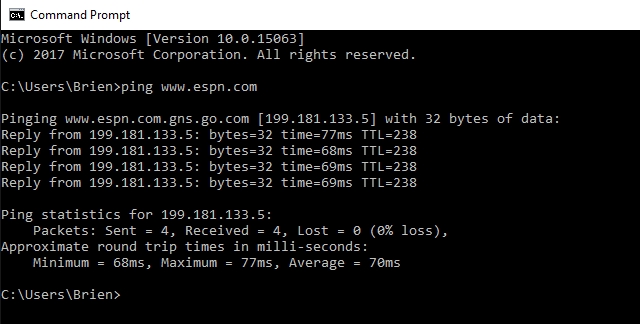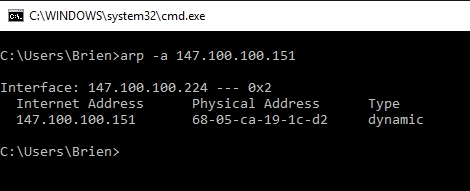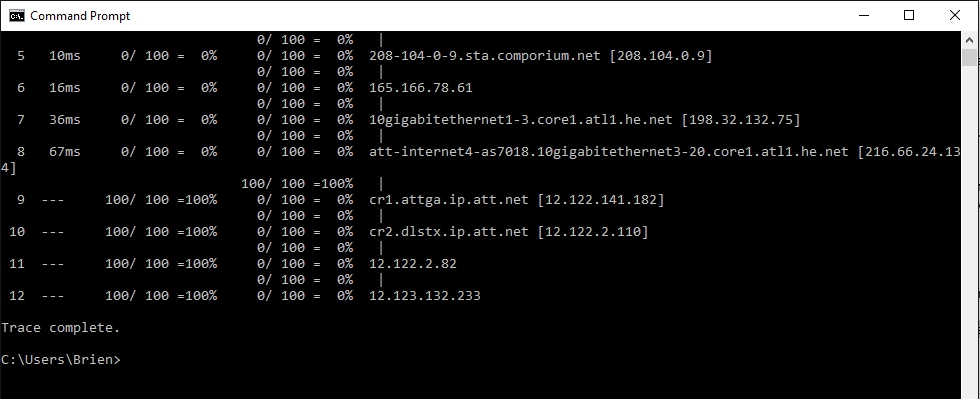11 networking commands every Windows admin should use
The Windows operating system contains numerous built-in, command line
networking utilities. These tools range from the obscure to the
commonplace. However, there are 11 built-in networking tools that
Windows networking administrators should be familiar with.
Ping is used to test the ability of one network host to communicate with another. Simply enter the Ping command, followed by the name or the IP address of the destination host. Assuming that there are no network problems or firewalls preventing the ping from completing, the remote host will respond to the ping with four packets. Receiving these packets confirms that a valid and functional network path exists between the two hosts.

Windows devices maintain an ARP cache, which contains the results of recent ARP queries. You can see the contents of this cache by using the ARP -A command. If you are having problems communicating with one specific host, you can append the remote host’s IP address to the ARP -A command.

Windows uses several different methods to map NetBIOS names to IP addresses, such as broadcast, LMHost lookup, or even using the nearly extinct method of querying a WINS server.
Of course, NetBIOS over TCP/IP can occasionally break down. The NbtStat command can help you to diagnose and correct such problems. The NbtStat -n command for example, shows the NetBIOS names that are in use by a device. The NbtStat -r command shows how many NetBIOS names the device has been able to resolve recently.
Functionally, Tracert works similarly to Ping. The major difference is that Tracert sends a series of ICMP echo requests, and the request’s TTL increased by 1 each time. This allows the utility to display the routers through which packets are passing to be identified. When possible, Windows displays the duration and IP address or fully qualified domain name of each hop.

If you would like to see more detailed information, then type IPConfig /all. Doing so causes Windows to display IP address configuration that is much more verbose. This is also the command that you will have to use if you want to see which DNS server the Windows device is configured to use.
The IPConfig command can do much more than just display IP address configuration information. It also contains options that can help you to troubleshoot problems related to DNS and DHCP. For example, entering the IPConfig /FlushDNS command purges the contents of the computer’s DNS resolver cache.
The cool thing about the Route command is that it not only shows you the routing table, it lets you make changes. Commands such as Route Add, Route Delete, and Route Change allow you to make routing table modifications on an as needed basis. The changes that you make can be persistent or nonpersistent, depending on whether you use the -P switch.
Entering the PathPing command followed by a host name initiates what looks like a somewhat standard Tracert process. Once this process completes however, the tool takes 300 seconds (five minutes) to gather statistics, and then reports latency and packet loss statistics that are more detailed than those provided by Ping or Tracert.

One of the things that I really like about this tool is that although there are a number of optional switches that you can use, you don’t have to use any of them unless you want to. Entering the NetDiag command by itself will cause all of the available tests to be run.
In some cases, NetDiag can not only identify problems, but can also fix those problems. Obviously, NetDiag cannot automatically correct every problem that it finds, but appending the /Fix parameter to the command will tell NetDiag to attempt to fix the problem automatically.
The Windows operating system is jam packed with command line utilities. Many of these utilities are left over from operating systems that were introduced decades ago. Even so, the utilities that I have discussed in this article are every bit as useful today as they were when they were first introduced.
Ping
I am guessing that the ping command is probably the most familiar, and most widely used of the utilities being discussed in this article, but that does not make it any less essential.Ping is used to test the ability of one network host to communicate with another. Simply enter the Ping command, followed by the name or the IP address of the destination host. Assuming that there are no network problems or firewalls preventing the ping from completing, the remote host will respond to the ping with four packets. Receiving these packets confirms that a valid and functional network path exists between the two hosts.

NetStat
If you are experiencing problems with network communications, then network statistics can sometimes help point you toward the root cause of the problem. That’s where the aptly named NetStat command comes into play. This command has a number of different functions, but the most useful of these is to display network summary information for the device. To see this type of summary information, just type NetStat -e.ARP
The ARP command corresponds to the Address Resolution Protocol. Although it is easy to think of network communications in terms of IP addressing, packet delivery is ultimately dependent on the Media Access Control (MAC) address of the device’s network adapter. This is where the Address Resolution Protocol comes into play. Its job is to map IP addresses to MAC addresses.Windows devices maintain an ARP cache, which contains the results of recent ARP queries. You can see the contents of this cache by using the ARP -A command. If you are having problems communicating with one specific host, you can append the remote host’s IP address to the ARP -A command.

NbtStat
As I am sure you probably know, computers that are running a Windows operating system are assigned a computer name. Oftentimes, there is a domain name or a workgroup name that is also assigned to the computer. The computer name is sometimes referred to as the NetBIOS name.Windows uses several different methods to map NetBIOS names to IP addresses, such as broadcast, LMHost lookup, or even using the nearly extinct method of querying a WINS server.
Of course, NetBIOS over TCP/IP can occasionally break down. The NbtStat command can help you to diagnose and correct such problems. The NbtStat -n command for example, shows the NetBIOS names that are in use by a device. The NbtStat -r command shows how many NetBIOS names the device has been able to resolve recently.
Hostname
The previously discussed NbtStat command can provide you with the host name that has been assigned to a Windows device, if you know which switch to use with the command. However, if you’re just looking for a fast and easy way of verifying a computer’s name, then try using the Hostname command. Typing Hostname at the command prompt returns the local computer name.Tracert
Contrary to what a rather infamous YouTube video might lead you to believe, Tracert isn’t pronounced “Tracer T,” nor can it show you how many people are using Google right this second. Instead, Tracert, or “Trace Route,” is a utility for examining the path to a remote host.Functionally, Tracert works similarly to Ping. The major difference is that Tracert sends a series of ICMP echo requests, and the request’s TTL increased by 1 each time. This allows the utility to display the routers through which packets are passing to be identified. When possible, Windows displays the duration and IP address or fully qualified domain name of each hop.
IpConfig
One utility that I find myself using constantly is IPConfig. At its simplest, the IPConfig command will display basic IP address configuration information for the device. Simply type IPConfig at the Windows command prompt, and you will be presented with the IP address, subnet mask, and default gateway that the device is currently using.
If you would like to see more detailed information, then type IPConfig /all. Doing so causes Windows to display IP address configuration that is much more verbose. This is also the command that you will have to use if you want to see which DNS server the Windows device is configured to use.
The IPConfig command can do much more than just display IP address configuration information. It also contains options that can help you to troubleshoot problems related to DNS and DHCP. For example, entering the IPConfig /FlushDNS command purges the contents of the computer’s DNS resolver cache.
NSLookup
NSLookup is a great utility for diagnosing DNS name resolution problems. Just type the NSLookup command, and Windows will display the name and IP address of the device’s default DNS server. From there, you can type host names in an effort to see if the DNS server is able to resolve the specified host name.Route
IP networks use routing tables to direct packets from one subnet to another. The Windows Route utility allows you to view the device’s routing tables. To do so, simply type Route Print.The cool thing about the Route command is that it not only shows you the routing table, it lets you make changes. Commands such as Route Add, Route Delete, and Route Change allow you to make routing table modifications on an as needed basis. The changes that you make can be persistent or nonpersistent, depending on whether you use the -P switch.
PathPing
Earlier, I talked about the Ping utility and the Tracert utility, and the similarities between them. As you might have guessed, the PathPing tool is a utility that combines the best aspects of Tracert and Ping.Entering the PathPing command followed by a host name initiates what looks like a somewhat standard Tracert process. Once this process completes however, the tool takes 300 seconds (five minutes) to gather statistics, and then reports latency and packet loss statistics that are more detailed than those provided by Ping or Tracert.

NetDiag
Perhaps the most useful of the network utilities that are built into Windows is NetDiag. The NetDiag command is designed to run a battery of tests on the computer in order to help the technician figure out why the computer is experiencing networking problems.One of the things that I really like about this tool is that although there are a number of optional switches that you can use, you don’t have to use any of them unless you want to. Entering the NetDiag command by itself will cause all of the available tests to be run.
In some cases, NetDiag can not only identify problems, but can also fix those problems. Obviously, NetDiag cannot automatically correct every problem that it finds, but appending the /Fix parameter to the command will tell NetDiag to attempt to fix the problem automatically.
The Windows operating system is jam packed with command line utilities. Many of these utilities are left over from operating systems that were introduced decades ago. Even so, the utilities that I have discussed in this article are every bit as useful today as they were when they were first introduced.



Comments
Post a Comment